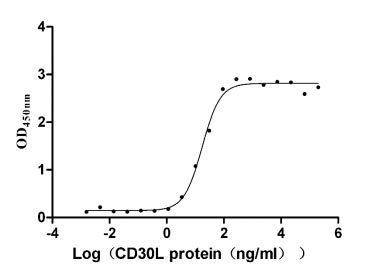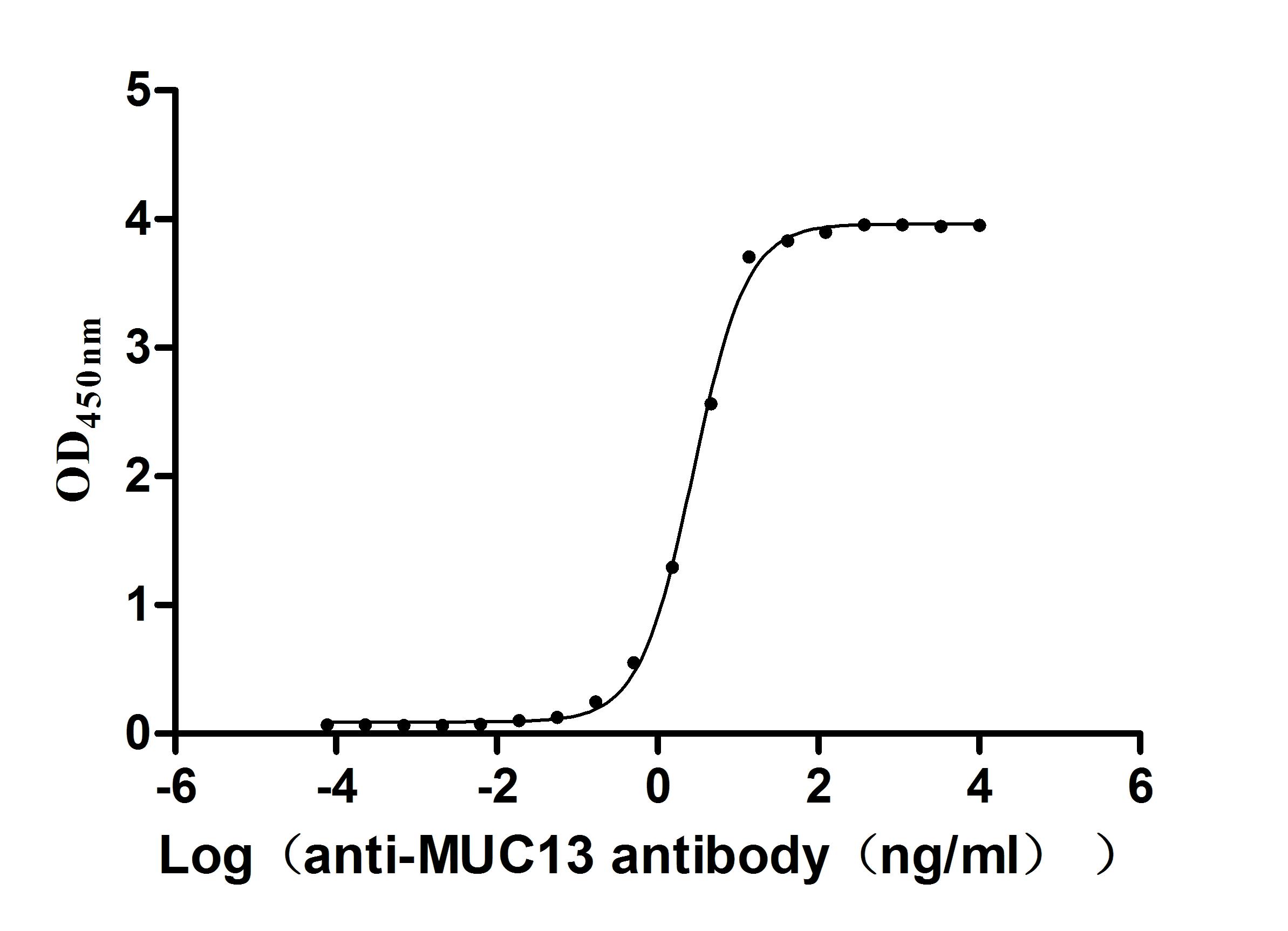Recombinant Mouse G-protein coupled receptor 161 (Gpr161)
-
货号:CSB-CF009774MO
-
规格:
-
来源:in vitro E.coli expression system
-
其他:
产品详情
-
基因名:
-
Uniprot No.:
-
别名:Gpr161; Gm208; G-protein coupled receptor 161
-
种属:Mus musculus (Mouse)
-
蛋白长度:Full length protein
-
表达区域:1-545
-
氨基酸序列MDFVQHALLTASRGALTMSLNSSLSYRKELSNLTATEGGEGGAVSEFIAIIIITVLVCLG NLVIVVTLYKKSYLLTLSNKFVFSLTLSNFLLSVLVLPFVVTSSIRREWIFGVVWCNFSA LLYLLISSASMLTLGVIAIDRYYAVLYPMVYPMKITGNRAVMALVYIWLHSLIGCLPPLF GWSSVEFDEFKWMCVAAWHQEPGYTIFWQIWCALFPFLIMLVCYGFIFRVARVKARKVHC GTVVTVEEDSQRSGRKNSSTSTSSSGSRRNALQGVVYSANQCKALITILVVIGAFMVTWG PYMVVITSEALWGKNCVSPTLETWATWLSFTSAICHPLIYGLWNKTVRKELLGMCFGDRY YRESFVQRQRTSRLFSISNRITDLGLSPHLTALMAGGQSLGHSSSTGDTGFSYSQDSGTD VMLLEDGTSEDNPPQHCTCPPKRRSSVTFEDEVEQIKEAAKNSLLHVKAEVHKSLDSYAA SLAKAIEAEAKINLFGEEALPGVLFTARTVPGAGFGGRRGSRTLVNQRLQLQSIKEGNVL AAEQR
Note: The complete sequence including tag sequence, target protein sequence and linker sequence could be provided upon request. -
蛋白标签:N-terminal 10xHis-tagged
-
产品提供形式:Liquid or Lyophilized powder
Note: We will preferentially ship the format that we have in stock, however, if you have any special requirement for the format, please remark your requirement when placing the order, we will prepare according to your demand. -
缓冲液:Lyophilized from Tris/PBS-based buffer, 6% Trehalose, pH 8.0
-
储存条件:Store at -20°C/-80°C upon receipt, aliquoting is necessary for mutiple use. Avoid repeated freeze-thaw cycles.
-
保质期:The shelf life is related to many factors, storage state, buffer ingredients, storage temperature and the stability of the protein itself.
Generally, the shelf life of liquid form is 6 months at -20°C/-80°C. The shelf life of lyophilized form is 12 months at -20°C/-80°C. -
货期:Basically, we can dispatch the products out in 1-3 working days after receiving your orders. Delivery time may differ from different purchasing way or location, please kindly consult your local distributors for specific delivery time.Note: All of our proteins are default shipped with normal blue ice packs, if you request to ship with dry ice, please communicate with us in advance and extra fees will be charged.
-
注意事项:Repeated freezing and thawing is not recommended. Store working aliquots at 4°C for up to one week.
-
Datasheet & COA:Please contact us to get it.
相关产品
靶点详情
-
功能:Key negative regulator of Shh signaling, which promotes the processing of GLI3 into GLI3R during neural tube development. Recruited by TULP3 and the IFT-A complex to primary cilia and acts as a regulator of the PKA-dependent basal repression machinery in Shh signaling by increasing cAMP levels, leading to promote the PKA-dependent processing of GLI3 into GLI3R and repress the Shh signaling. In presence of SHH, it is removed from primary cilia and is internalized into recycling endosomes, preventing its activity and allowing activation of the Shh signaling. Its ligand is unknown.
-
基因功能参考文献:
- Gpr161 promotes forelimb formation, regulates limb patterning, prevents periarticular chondrocyte proliferation and drives osteoblastogenesis in intramembranous bones in a cilium-dependent manner. PMID: 29222391
- These studies demonstrate that modification of the Gpr161vl/vl cataract phenotype is likely due to genetic variants in at least one of three closely linked candidate genes on proximal Chromosome 15. PMID: 28135291
- Smoothened determines beta-arrestin-mediated removal of the G protein-coupled receptor Gpr161 from the primary cilium. PMID: 27002170
- Gpr161 is a G-protein coupled receptor that regulates the retinoic acid and canonical Wnt pathways during neurulation PMID: 25753732
- Complete loss of Gpr161 in mouse causes midgestation lethality and increased Shh signaling in the neural tube, phenocopying Tulp3/IFT-A mutants. PMID: 23332756
- Characterization of the vl mutation indicates that C-terminal tail of Gpr161 is truncated, leading to multiple effects on the protein, including reduced receptor-mediated endocytosis PMID: 18250320
- Gpr161 is required for left-right patterning. PMID: 18755178
显示更多
收起更多
-
相关疾病:An intragenic deletion in Gpr161 is responsible for the vacuolated lens (vl) phenotype that is characterized by neural tube defects and congenital cataracts. The vl mutation aroses spontaneously. About half of vl/vl embryos display lumbar-sacral spina bifida and die before birth, and the other half have closed neural tubes but show thinning of the midline neuroepithelium and epidermis, dilation of the dorsal ventricle, and presence of ectopic neuroepithelial cells in the ventricle. All surviving adults display congenital cataracts (PubMed:18250320). It is not a null mutant allele (PubMed:23332756).
-
亚细胞定位:Cell projection, cilium membrane; Multi-pass membrane protein. Cell membrane; Multi-pass membrane protein. Note=Mainly localizes to primary cilium in a TULP3 and IFT-A complex-dependent manner. In presence of SHH, it is removed from primary cilia and is internalized into recycling endosomes and is apparently not degraded.
-
蛋白家族:G-protein coupled receptor 1 family
-
数据库链接:
KEGG: mmu:240888
STRING: 10090.ENSMUSP00000136621
UniGene: Mm.329929
Most popular with customers
-
Recombinant Human Tumor necrosis factor receptor superfamily member 8 (TNFRSF8), partial (Active)
Express system: Mammalian cell
Species: Homo sapiens (Human)
-
Recombinant Human Tumor necrosis factor ligand superfamily member 8 (TNFSF8), partial (Active)
Express system: Mammalian cell
Species: Homo sapiens (Human)
-
Recombinant Human HLA class II histocompatibility antigen gamma chain (CD74), partial (Active)
Express system: Mammalian cell
Species: Homo sapiens (Human)
-
Recombinant Human Microtubule-associated protein tau (MAPT) (Active)
Express system: Mammalian cell
Species: Homo sapiens (Human)
-
Recombinant Rat Gastric inhibitory polypeptide receptor (Gipr), partial (Active)
Express system: Mammalian cell
Species: Rattus norvegicus (Rat)
-
Recombinant Mouse Cytotoxic and regulatory T-cell molecule (Crtam), partial (Active)
Express system: Mammalian cell
Species: Mus musculus (Mouse)
-
Recombinant Human Cadherin-1(CDH1),partial (Active)
Express system: Mammalian cell
Species: Homo sapiens (Human)
-
Recombinant Human Mucin-13(MUC13),partial (Active)
Express system: yeast
Species: Homo sapiens (Human)




-AC1.jpg)
-AC1.jpg)














